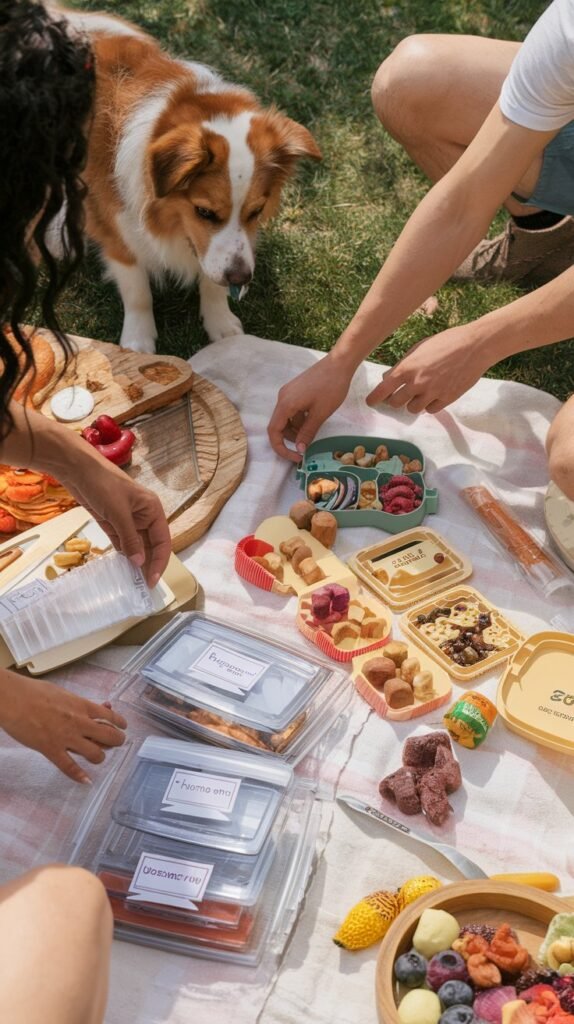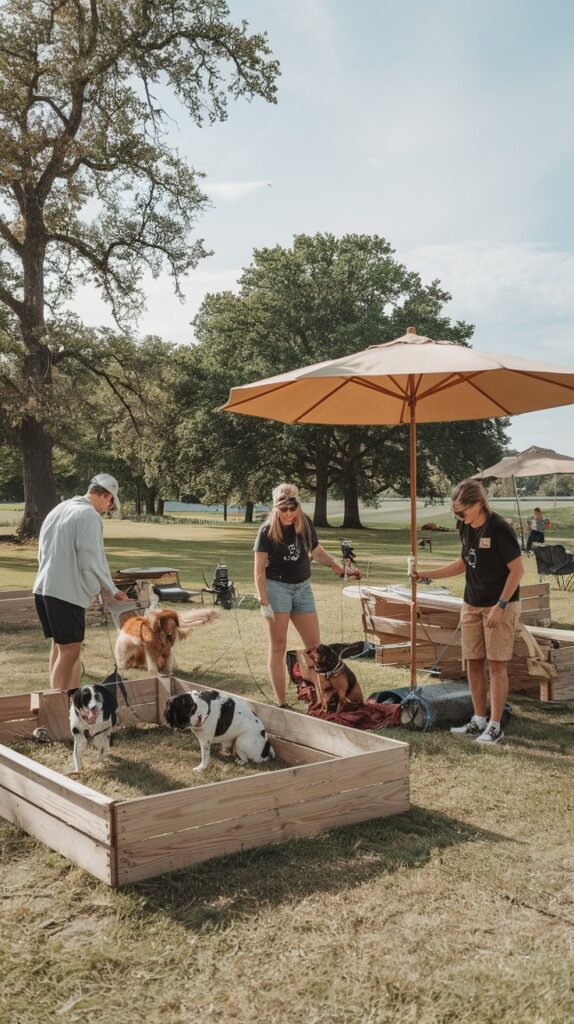Dog picnics offer a wonderfully inclusive approach to outdoor dining, combining the joy of human refreshment with the playful delight of canine companionship. These tail-wagging celebrations bring together pet-safe foods, dog-friendly environments, and engaging activities in settings that transform ordinary parks, pet-welcoming beaches, or backyard spaces into extraordinary bonding experiences that strengthen the special connection between humans and their four-legged family members.
Let’s explore how to create the perfect dog picnic that balances human enjoyment with canine companionship for outdoor success!
Dog Picnic Planning Fundamentals
Establish the perfect foundation for your canine-inclusive outdoor celebration.
Understanding Modern Dog Picnic Approaches
Creating enjoyable yet practical canine-inclusive outdoor dining:
- Pet-Human Boundary Priority: Clear delineation of spaces and activities
- Safety Consideration Focus: Environment assessment from dog perspective
- Behavior Management Strategy: Appropriate control and freedom balance
- Multi-Dog Dynamics Planning: Interaction management between canines
- Food Separation Integration: Preventing inappropriate consumption
- Energy Pattern Recognition: Aligning with natural dog activity cycles
- Regulation Compliance Enhancement: Following location-specific rules
“Dog picnics require a thoughtful balance between human enjoyment and canine needs,” shares Bailey, who specializes in pet-inclusive events. “We approach these gatherings with what we call ‘species-appropriate parallelism’—carefully creating experiences where both humans and dogs can enjoy themselves simultaneously but in species-appropriate ways. The most successful dog picnics establish clear but not rigid boundaries between human dining spaces and dog activity areas, thoughtfully manage the energy flow of the event to align with natural canine patterns, and proactively address potential challenges like food security and waste management. When properly executed, these dual-species gatherings create joyful shared memories while respecting the different ways humans and dogs experience outdoor enjoyment.”
Location Selection Strategy
Finding the perfect setting for canine-human enjoyment:
- Pet Regulation Assessment: Location-specific dog policies
- Space Adequacy Consideration: Appropriate room for dual activities
- Safety Evaluation Focus: Environment from canine perspective
- Other Dog Presence Planning: Managing unexpected interactions
- Natural Hazard Recognition: Plants, wildlife, terrain concerns
- Shade and Water Availability: Essential canine comfort elements
- Containment Option Assessment: Security features for varying dog types
“Selecting the right location creates the essential foundation for dog picnic success,” explains Riley, who plans pet-friendly outdoor events. “We’ve found the most effective approach is what we call ‘dual-species suitability’—identifying spaces that meet both human aesthetic desires and practical canine needs. We particularly recommend seeking locations with clear dog policies to avoid uncomfortable enforcement encounters, natural boundaries that help define dog activity areas without restrictive leashing when possible, and appropriate terrain that suits your specific dog’s needs—perhaps open fields for active breeds, water access for swimming lovers, or quieter wooded areas for more sensitive dogs. The perfect dog picnic location balances human dining pleasure with canine enjoyment opportunities—providing the aesthetic setting humans appreciate while including the activity potential, safety features, and comfort elements essential for dogs.”
Packing Strategy Development
Maintaining organization with dual-species considerations:
- Species Separation Priority: Clear delineation of human/dog supplies
- Food Security Focus: Appropriate containment for each cuisine type
- Dog Comfort Integration: Essential canine environmental needs
- Behavior Management Supply Planning: Training reinforcement tools
- Waste Management Strategy: Comprehensive cleanup preparation
- Emergency Preparation Consideration: First aid for both species
- Activity Supply Organization: Entertainment for varying energy levels
“Dog picnic packing requires specialized approaches that address the unique challenges of transporting supplies for two species with very different needs,” shares Cooper, who specializes in pet-friendly outdoor experiences. “We develop what we call ‘compartmentalized preparation’—creating distinct but coordinated systems for human and canine supplies. We generally recommend using clearly designated containers that prevent cross-contamination between human food and dog supplies, packing in logical access sequence based on arrival needs, and including specialized dog-specific elements often forgotten in standard picnic planning—portable water bowls, secure tie-out systems appropriate to your location, and comfort items like portable shade or cooling mats for hot days. The most effective packing strategies balance comprehensive preparation with manageable transport—focusing on multi-functional items when possible while never compromising on essential safety elements like secure food storage and waste management supplies.”
Dog Picnic Food
Dual cuisine designed for species-appropriate enjoyment.
Dog picnic cuisine requires careful consideration of both human dining pleasure and canine health, with particular attention to separation, safety and appropriateness for outdoor conditions. The ideal approach prioritizes clear delineation between human-only foods and dog-appropriate options while creating special moments of shared enjoyment through carefully selected treats suitable for both species.
| Human-Only Picnic Foods | Dog-Safe Special Treats | Dog Activity Food Dispensers | Shared-Friendly Options |
|---|---|---|---|
| Chicken Salad Sandwiches | Freeze-Dried Meat Treats | Stuffable Rubber Toys | Plain Grilled Chicken |
| Pasta Salad with Onions | Training Treat Variety | Puzzle Treat Dispensers | Carrot Sticks |
| Chocolate Desserts | Commercial Dog Biscuits | Slow-Feeder Mats | Apple Slices (no seeds) |
| Cheese and Charcuterie | Dehydrated Sweet Potato | Lick Mats | Plain Rice Cakes |
| Grapes and Raisins | Dog-Safe Peanut Butter | Treat-Dispensing Balls | Plain Watermelon |
| Onion-Containing Dips | Frozen Dog-Safe Yogurt | Snuffle Mats | Blueberries |
| Mixed Nuts | Dried Fish Treats | Wobble Feeders | Plain Green Beans |
| Alcohol Beverages | Dog Ice Cream | Treat-Hiding Toys | Plain Pumpkin Puree |
Creating Dog Picnic Food Successfully
Techniques for enjoyable yet safe dual-species dining:
- Separation Priority: Clear physical distinction between species’ food
- Toxic Prevention Focus: Elimination of dangerous human foods
- Portion Control Strategy: Appropriate amounts for canine digestion
- Enrichment Integration: Mental stimulation through food presentation
- Training Opportunity Enhancement: Reinforcement of good manners
- Heat Consideration Planning: Temperature-appropriate canine options
- Hydration Management Focus: Adequate water alongside food options
“I approach dog picnic food with what I call ‘joyful segregation’—creating clearly distinct culinary experiences that protect both human enjoyment and canine health,” shares Max, who specializes in pet nutrition and events. “We emphasize establishing physical and visual boundaries between human and dog food areas—perhaps using separate blankets with several feet of distance, elevation differences like tables for human food with floor-level dog stations, or containment systems that prevent opportunistic canine sampling of human fare. The most successful dog picnic food strategies balance separation with special moments of appropriate sharing—perhaps bringing separate containers of plain grilled chicken or vegetables without seasonings harmful to dogs that can be enjoyed by both species, creating ‘parallel dining’ where each enjoys appropriate versions of similar foods, or incorporating interactive canine feeding options like puzzle toys that keep dogs engaged with their own food rather than eyeing human plates.”
Dog Picnic Activities
Engaging entertainments that enhance cross-species connection.
Dog-inclusive activities create meaningful engagement opportunities beyond just eating, transforming picnics into relationship-building experiences. The ideal approach incorporates elements that strengthen the human-animal bond, provide appropriate physical and mental stimulation for different dog personalities, and balance active play with quieter connection moments.
| Training Opportunity Activities | Active Play Options | Quiet Bonding Experiences | Social Development Elements |
|---|---|---|---|
| Basic Command Practice | Fetch Variations | Gentle Massage | Controlled Greetings |
| Recall Games | Frisbee Tossing | Relaxed Grooming | Parallel Walking |
| “Leave It” Training | Tug-of-War | Quiet Cuddle Time | Scent Introduction |
| Impulse Control Exercises | Bubble Chasing | Hand Feeding | Shared Space Management |
| Environmental Distraction Work | Water Play | Treat Puzzles Together | Resource Respect Practice |
| Boundary Training | Flirt Pole Play | Photography Sessions | Appropriate Play Modeling |
| Trick Performance | Ball Games | Rest Together Time | Command Response Around Others |
| Portable Agility Elements | Scent Tracking | Gentle Petting Sessions | Calm Greeting Reinforcement |
Creating Engaging Dog Picnic Activities
Techniques for meaningful cross-species enjoyment:
- Energy Management Priority: Balancing activity with settling periods
- Training Integration Focus: Reinforcing good manners naturally
- Individual Personality Consideration: Activities matching dog temperament
- Bond Strengthening Strategy: Connection-enhancing interactions
- Human-Dog Parallel Play: Simultaneous enjoyment opportunities
- Environmental Management Planning: Appropriate activity zones
- Socialization Opportunity Enhancement: Controlled positive exposures
“I approach dog picnic activities with what I call ‘bonded enrichment’—creating engaging experiences that strengthen relationships while respecting canine needs,” shares Charlie, who specializes in dog behavior and training. “We emphasize developing a balanced activity plan that addresses the three core canine needs: physical exercise through active play appropriate to your dog’s energy level and age; mental stimulation through training games, scent work, or puzzle toys; and social connection through quiet bonding and appropriate interactions with both humans and other dogs when present. We particularly recommend incorporating brief training moments throughout the picnic that naturally reinforce good outdoor manners—perhaps practicing ‘leave it’ with food temptations, reinforcing reliable recalls between play sessions, or rewarding calm settling on the picnic blanket—creating practical skill-building opportunities disguised as enjoyable picnic activities. The most successful dog picnic activity plans create natural cycles between more active play periods and quieter connection moments, respecting canine energy patterns while building positive associations with picnic environments.”
Dog Picnic Practicalities
Essential strategies for outdoor success with canine companions.
Dog Safety and Comfort Management
Creating secure, pleasant environments for canine guests:
- Temperature Regulation Priority: Appropriate cooling systems
- Secure Containment Focus: Freedom with necessary control
- Hazard Assessment Strategy: Environment evaluation from dog level
- Hydration Management Planning: Constant water availability
- Rest Opportunity Integration: Quiet space availability
- Paw Protection Consideration: Surface temperature and texture awareness
- Stress Monitoring Approach: Recognizing and addressing discomfort
“Dog picnic safety requires comprehensive planning that addresses the unique vulnerabilities canines face in outdoor settings,” explains Jordan, who designs pet-safe outdoor experiences. “We begin with what we call ‘preventative protection’—creating systems that manage risks before they become problems. We recommend establishing a clear checklist of environment assessment from a dog’s perspective—checking for hazards like toxic plants, sharp objects, or waste at ground level; evaluating temperature factors beyond just air temperature to include ground surface heat that can burn paws; and creating shade requirements that acknowledge dogs’ limited cooling abilities compared to humans. Having designated safety supplies accessible throughout the picnic—perhaps a specific bag containing first aid items, extra water, cooling tools for hot days, and emergency contact information—allows for immediate response to any situations that arise. The most successful dog picnic safety approaches balance necessary protection with natural enjoyment—maintaining essential security without creating such restrictive environments that the dogs cannot enjoy the outdoor experience.”
Behavior Management Strategy
Maintaining pleasant interactions in stimulating environments:
- Clear Expectation Priority: Consistent boundary setting
- Preventative Management Focus: Environment setup for success
- Reinforcement Strategy: Rewarding desired behaviors
- Arousal Level Monitoring: Recognizing escalating energy
- Appropriate Interruption Techniques: Redirection before problems
- Settling Skill Development: Teaching relaxation in stimulation
- Multiple Dog Dynamics Consideration: Managing group interactions
“Effective dog picnic behavior management transforms potentially challenging situations into enjoyable shared experiences through proactive approaches,” shares Taylor, who specializes in dog training for real-life situations. “We develop what we call ‘environmental success setting’—creating conditions where good behavior becomes the easiest choice for dogs. We recommend establishing clear but reasonable expectations appropriate to both your dog’s training level and the specific environment—perhaps requiring reliable recall and non-jumping in wide open spaces but accepting leashed management in more crowded areas; creating physical management systems like designated settling spots, appropriate containment options, or activity zones that naturally guide behavior; and preparing high-value reinforcement tools that acknowledge the increased distraction level outdoor gatherings present. The most successful behavior management approaches balance necessary structure with natural enjoyment—maintaining essential manners while accepting that picnic behavior will naturally differ from home behavior, creating a special but controlled freedom that makes these events memorable for both species.”
Special Dog Picnic Variations
Adapt your approach for different canine needs and situations.
Puppy’s First Picnic Experiences
Creating positive foundational outings for young dogs:
- Positive Association Priority: Building joyful environmental connections
- Duration Management Focus: Appropriate timeframes for development
- Socialization Opportunity Strategy: Controlled exposure benefits
- Overstimulation Prevention Planning: Recognizing and managing thresholds
- Appropriate Expectation Setting: Age-appropriate behavior standards
- Rest Enforcement Integration: Understanding puppy energy cycles
- Foundation Skill Development: Basic training in new environments
“First picnic experiences create foundational impressions that influence a puppy’s lifelong relationship with outdoor gatherings,” explains Harley, who specializes in early canine development. “We approach these initial outings with what we call ‘foundation building’—carefully creating positive associations while managing developmental limitations. We particularly recommend selecting quieter, more controlled environments for first experiences rather than busy public spaces; planning significantly shorter durations than adult dog outings, often just 20-30 minutes initially; and creating specific socialization opportunities that match your puppy’s developmental needs whether that’s gentle exposure to various surfaces, appropriate introduction to friendly adult dogs, or positive association with new environmental sounds. For particularly successful puppy picnics, consider incorporating brief training moments that build basic skills in new environments—perhaps practicing name attention, simple settling behaviors, or positive interactions with novel objects—while maintaining realistic expectations that acknowledge developmental stages and preventing the overstimulation that can create negative associations with these experiences.”
Senior Dog Picnic Adaptations
Creating comfortable experiences for aging canine companions:
- Comfort Maximization Priority: Appropriate padding and support
- Limited Mobility Accommodation: Accessible environment selection
- Temperature Sensitivity Consideration: Extra climate management
- Energy Conservation Strategy: Balanced activity with ample rest
- Medication Schedule Integration: Maintaining treatment timing
- Sensory Limitation Adaptation: Adjusting for vision/hearing changes
- Familiar Routine Maintenance: Reducing stress through consistency
“Senior dog picnics offer special opportunities for continued outdoor enjoyment when thoughtfully adapted to address the changing needs of aging canines,” shares Silver, who works with geriatric dog enrichment. “We develop what we call ‘comfortable continuity’—maintaining the joy of outdoor experiences while accommodating physical and cognitive changes. We recommend selecting environments with minimal challenging terrain that might stress aging joints; bringing significantly enhanced comfort items like orthopedic mats, extra blankets, or even portable raised beds that provide both physical support and familiar resting surfaces; and creating modified activity options that maintain mental stimulation while respecting physical limitations—perhaps scent games that can be enjoyed from a stationary position, gentle short-distance retrieves, or mentally engaging food puzzles. The most successful senior dog picnics balance necessary accommodations with dignified enjoyment—addressing limitations without creating a sense of exclusion, finding ways to include your senior companion in the outdoor experience while respecting their changing needs and celebrating the special quiet companionship that often characterizes relationships with older dogs.”
More Creative Dog Picnic Inspiration
Looking for additional canine-inclusive outdoor dining ideas? Here’s a collection of creative concepts!
| Unique Themes | Novel Activity Ideas | Creative Treat Presentations | Special Enhancement Concepts |
|---|---|---|---|
| Doggy Birthday Picnic | Bobbing for Tennis Balls | Frozen Treat “Pupsicles” | Portable Dog Photo Booth |
| Adoption Anniversary | Digging Pit Treasure Hunt | Layered Treat Parfaits | Custom Doggy Bandanas |
| Training Graduation Party | Obstacle Course Challenge | Stuffed Kong Stations | Paw Print Memory Art |
| Seasonal Holiday Theme | Scent Work Challenges | Bone-Shaped Snack Bar | Dog-Human Matching Accessories |
| Breed Meetup Gathering | Bubble Popping Contest | Cupcake-Style Meatballs | Personalized Water Bowls |
| Rescue Organization Fundraiser | Toy Identification Games | Pupcakes & Woofles | Charitable Donation Activities |
| New Dog Park Celebration | Hide & Seek Adventures | Biscuit Decorating Station | Community Education Components |
| Dog-Human Sports Theme | Swimming Dock Games | Frozen Yogurt Bar | Action Photography Service |
Conclusion: Celebrating Connection Through Cross-Species Joy
Dog picnics create memorable outdoor experiences through the perfect combination of human refreshment, canine enjoyment, and thoughtfully designed shared activities that transform ordinary outdoor dining into extraordinary bonding adventures that strengthen the special relationship between people and their dogs.
What makes dog picnics extraordinary is their ability to create genuinely inclusive experiences that acknowledge and celebrate the different ways humans and canines enjoy outdoor settings while building meaningful connections between the species. When thoughtfully planned with attention to both human dining pleasure and canine needs, these dual-species gatherings offer uniquely effective opportunities for strengthening relationships, building positive associations with outdoor environments, and creating shared memories that enhance the special bond between people and their dogs.
So prepare your washable picnic blanket, pack separate human and canine refreshments, and choose your perfect dog-friendly location for an afternoon of cross-species outdoor enjoyment. The relationships enhanced during these shared celebrations often become foundations for deeper understanding and appreciation that extends far beyond a single day of picnicking and creates lasting impacts on the human-canine connection.






























